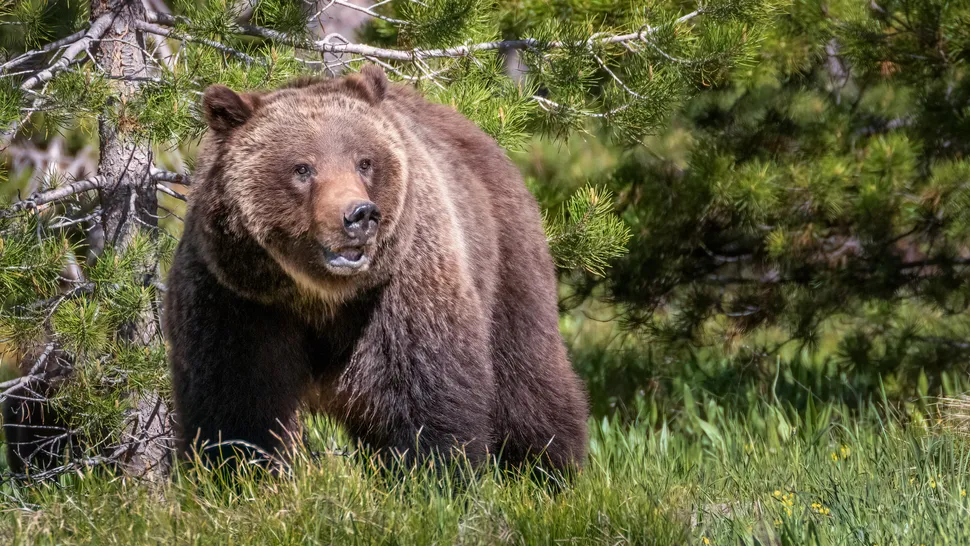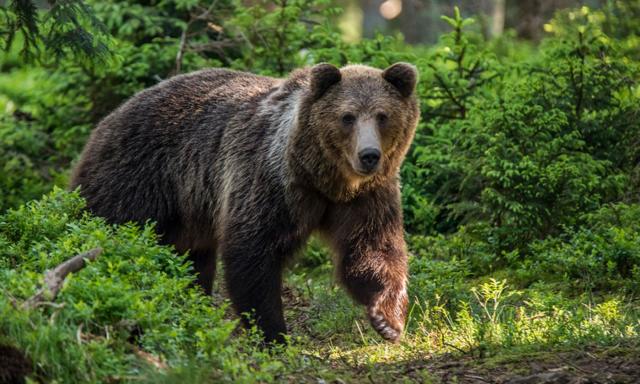Ponder the most dangerous bear in the world, and you might naturally think of the mighty polar bear – king of the Arctic and most carnivorous of ursids – or the big and ornery North American grizzly. But the species that actually mauls the most people on average each year? The smaller, galumphing, and far less predatory sloth bear of the Indian subcontinent.
Basically anteaters in ursid disguise, sloth bears are uniquely specialised for feeding on ants and termites (aka myrmecophagy); seasonally ripe fruits and honey help round out their diet. Yet a recent tally of all recorded attacks on people by large carnivores across the world between 1950 and 2019 attributed more to sloth bears than any other species – various dreaded big cats included.
The aggressiveness of the otherwise seemingly placid bug-slurping sloth bear has been long been recognised, even in tiger- and leopard-prowled country. “Should an unarmed wayfarer meet Master Bruin engaged in looking over his orchards, or sauntering over his domain, let him step aside silently lest he have his scalp drawn over his face, or his features so altered as to be unrecognisable by his most intimate friends,” wrote hunter Edward B. Baker in 1887’s Sport in Bengal.

Sloth bears indeed often direct their attacks at a person’s face, inflicting massive damage with their impressively long canines and claws. Earlier this month, a sloth bear killed a man and injured two others in India’s Chhattisgarh state; two farmers were mauled to death and another wounded last March in Andhra Pradesh when they encountered a sloth bear in a cashew orchard.
A new study published in Ecology & Evolution (from which we nabbed that Baker quote) suggests the dangerous pugnacity of the sloth bear is likely an anti-predator strategy evolved over several million years sharing the landscape with big cats – including, today, the royal Bengal tiger.
Though scientifically addressed in the paper, that theory wasn’t necessarily breaking news. One of the study’s authors, wildlife ecologist Thomas Sharp, told the New York Times he’d long asked local people living among sloth bears about their aggressiveness, and been told, “It’s because they fight with tigers.”
Specifically, it’s that violent defensiveness of the sloth bear combined with the landscapes it inhabits that seem to explain the relative danger it poses to humans. Some 90% of sloth bears today reside in India, the most populous country on Earth, and the species rubs shoulders very closely with people – not the same situation polar or grizzly bears, say, face across much of their range.
Bengal tigers – along with their relatives Amur tigers, as big as big cats come these days – occasionally kill and eat sloth bears. The bear’s food-getting routine, as the paper notes, puts them at special risk of tiger attack. Sloth bears shuffle about in forests, woodlands, scrub, and grasslands, with their heads to the ground sniffing for the scent of subterranean insect nests, blowing dirt away and sucking up their tiny quarry. Let’s just say it’s not a lifestyle that lends itself to extreme vigilance – and a tiger, a stalk-and-ambush sort of hunter, can often sneak within whisker’s reach of a bear without blowing its cover.
Here’s the deal, though: The sloth bear’s no pushover. Single-minded and hapless as this endearingly disheveled-looking ursid may appear while foraging, it can turn beast-mode on a dime. Upon noticing its predator – and “noticing,” in some cases, may be getting outright pounced upon – the bear often mounts a furious counter-attack, rearing up on hind legs, swiping with those hooked paws, huffing or roaring, and hurtling forward in fierce charges.
The Ecology & Evolution analysis, which took advantage of the relative proliferation of videos and photos capturing tiger/sloth-bear encounters in our smartphone age to study the phenomenon, suggests this is a pretty effective behaviour.
In the vast majority of cases it considered, little physical contact between tiger and bear ended up occurring, and neither species incurred injury. At medium and long ranges, sloth bears responded to tigers they keyed into in a variety of ways, including running away or staying still and watching the cat. But in up-close run-ins – a bear noticing a tiger within three metres – sloth bears “almost always reacted explosively, standing and then charging,” the study authors wrote. One defensive rush by the bear concluded most of these interactions, “indicating the general success of this strategy.”
Standing on its hind legs, a sloth bear reveals its bold white chest marking – a pattern it shares with sun bears and Asiatic black bears, which scientists have speculated may have developed in the three species to intimidate an attacking big cat. A tiger that can leap upon a bear from behind has a shot at dispatching it; a bear that detects its would-be predator and stands to face it makes a more formidable opponent, changing the odds – enough so that a tiger will often withdraw. The white crescent on the bear’s chest, the theory goes, makes the bear more imposing and drives home to the tiger that its attempted prey is aware and ready to actively defend itself.

(Along the same lines: Back in the late 1980s, a now-famous attempt to reduce the threat of tiger attacks in the Sundarbans mangrove forest on the India-Bangladesh borderland involved people wearing masks on the backs of their heads, the idea being tigers often attack from behind, and would be less inclined to do so if they mistook a mask for a person’s face aimed at them. It’s a tactic still sometimes employed.)
The study analysed 14 close encounters between sloth bears and tigers, 13 of which saw the bear stand, charge, and/or swat at the tiger and the encounter end without physical harm to either party. “In the single case where a bear showed no aggression, but simply remained still and whined loudly,” the authors wrote, “it was quickly dispatched, along with the cub on her back, by a large male tiger.”
The study notes that a number of the adaptations the sloth bear evolved for its myrmecophagous meal plan also double as part of its tiger defense system. The same long, curved claws the bear employs to dig out ant and termite nests are their number-one weapons against a big, striped threat. Sloth bears are also as splendidly shaggy as bears come; their long-haired coats not only lend them protection against ant bites, but also the rather more serious bites (and swipes) of tigers. Analysis of one of the videos the researchers examined suggested the thick neck ruff of a female sloth bear likely allowed it to endure a protracted assault by a big male tiger.
That hirsute coat also allows sloth-bear cubs to hitch rides atop their mothers: a primate-like behaviour not seen in other bears. There’s speculation that this is another anti-predator trait, given the digging claws of the sloth bear make even cubs mediocre at climbing trees, a defense strategy employed by two other ursids that contend with tigers, the sun bear and Asiatic black bear. A female sloth bear with her one or two cubs riding piggyback is free to throw herself, all gaping jaws and punching claws, against a tiger. (And sometimes not just one tiger: A case reported in a 1999 paper saw a mother sloth bear with cubs apparently ward off three of the predators.)

The new paper puts the sloth bear’s dealings with big cats in some fascinating evolutionary context. Evidence suggests modern tigers had crossed the Himalaya by 20,000 years ago, and subsequently spread across India. Sloth bears, which apparently never ranged much beyond their modern geography of present-day India as well as Sri Lanka, Bangladesh (where they’ve been extirpated), and the Terai lowlands of Nepal, have dealt with tigers since then – and also the roughly contemporaneous Asiatic lion, once much more widespread on the Indian subcontinent. (Though Asiatic lions – restricted to a tiny remnant range centred on the Greater Gir Landscape – don’t cross paths with sloth bears today in India, their group-hunting behaviour might conceivably have made them historically even more threatening to the bears than tigers.)
But the lineage of sloth bears appears to be several million years old, and they’ve apparently had to worry about huge felids for far longer than the tiger’s or lion’s arrival: The sloth bear’s ancient distribution and timeline overlapped with the saber-toothed cats Dinofelis and Megantereon as well as the Eurasian jaguar, which went extinct some 35,000 years ago. In other words, the sloth bear – outsized by its conspecific felids and unable to scramble up a tree – has long needed to protect itself in a more take-charge manner.
The ultimate thrust of the article is that the furious, hair-trigger bluster adopted by the sloth bear as a counter-assault against a predatory big cat doesn’t mix well with human beings. Most sloth bears today, after all, share landscapes densely populated by people. And a farmer or woodcutter can stumble as close to a head-down, ant-snuffling sloth bear as a hunting tiger – and thereby provoke the same immediate defensive aggression.

Trying to avoid such a sudden close encounter in the first place is a person’s best bet at avoiding a serious – maybe fatal – mauling, so making plenty of noise is good practice when wandering a bear-roamed wood. If confronted at close range or attacked, playing dead is the recommended response; the sloth bear, after all, is simply trying to neutralise a perceived threat, not eat you (or a tiger). Running away is not a good idea: A fleeing tiger might be able to outpace a sloth bear, but most people probably can’t.
Rearing, charging, and – if need be – swatting big cats has helped sloth bears survive amid those fearsome predators for a very long time. In a heavily and densely human-settled subcontinent, the strategy now tends to get the bear – which the IUCN Red List classifies as “Vulnerable” with a declining (and very habitat-fragmented) population – in trouble.
“Explosively charging and attacking a potential threat has served sloth bears well for hundreds of thousands, if not millions, of years,” the authors of the study conclude. “Only in recent times has this defensively aggressive behaviour become an issue for the conservation of the species: sloth bears that attack people are often killed, and local people that fear these bears are often not inclined to favour the presence of nearby populations.”
The IUCN’s 2017 Sloth Bear Global Assessment suggested conflict with people, in concert with drastic habitat loss, could see the species’ population decline by more than 30 percent in the coming few decades. The future of the tiger-fighting bear, in other words, is very much up in the air.
This article by Ethan Shaw was first published by Earth Touch News on 22 Augsut 2024. Lead Image: Fear me! I am sloth bear. Image © Paul Williams.
What you can do
Help to save wildlife by donating as little as $1 – It only takes a minute.







Leave a Reply